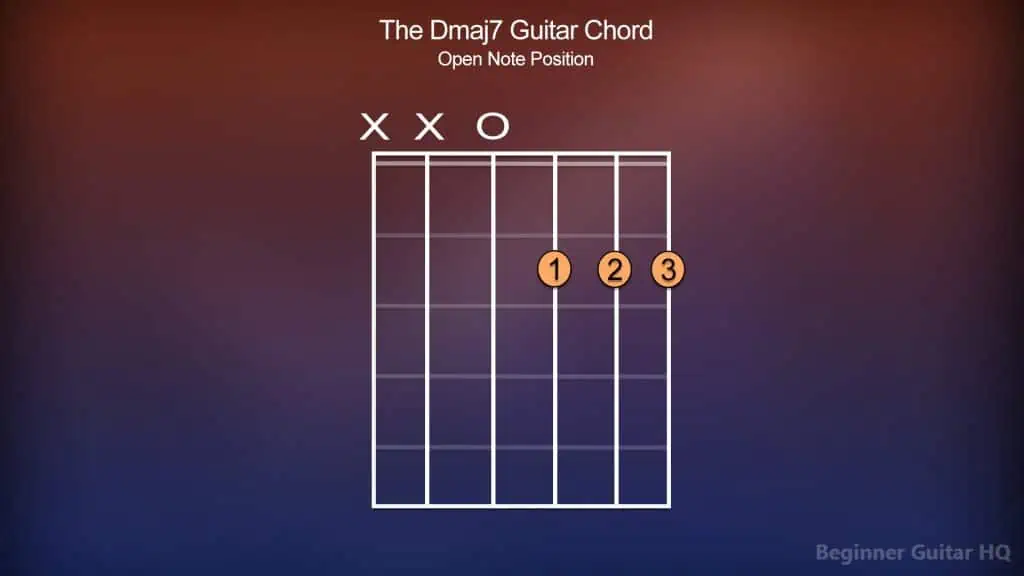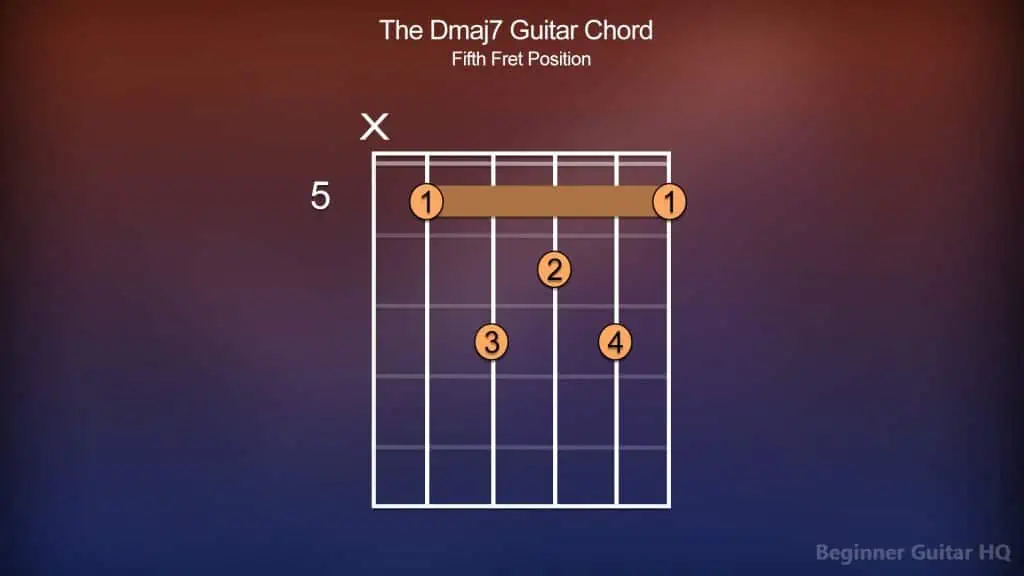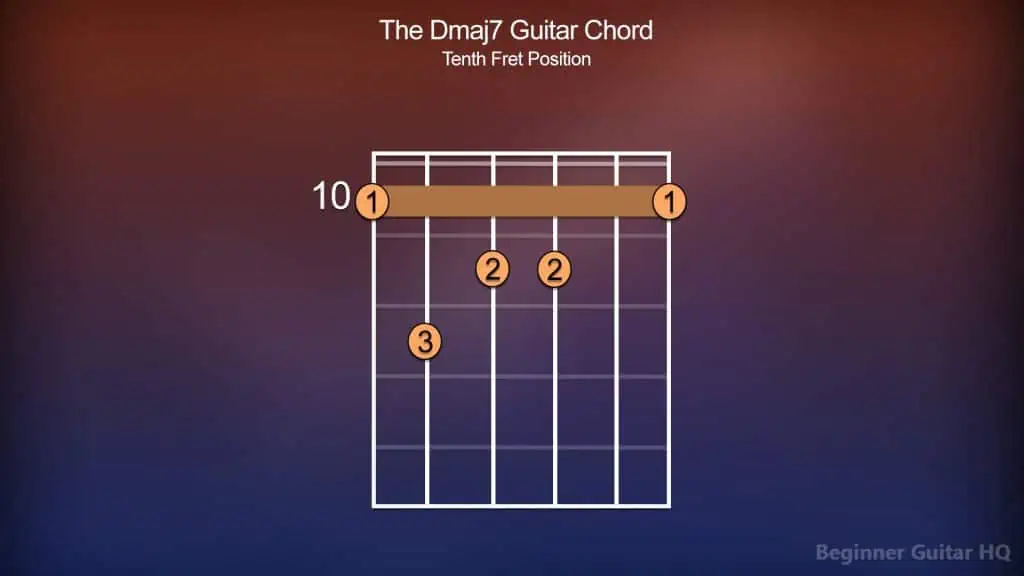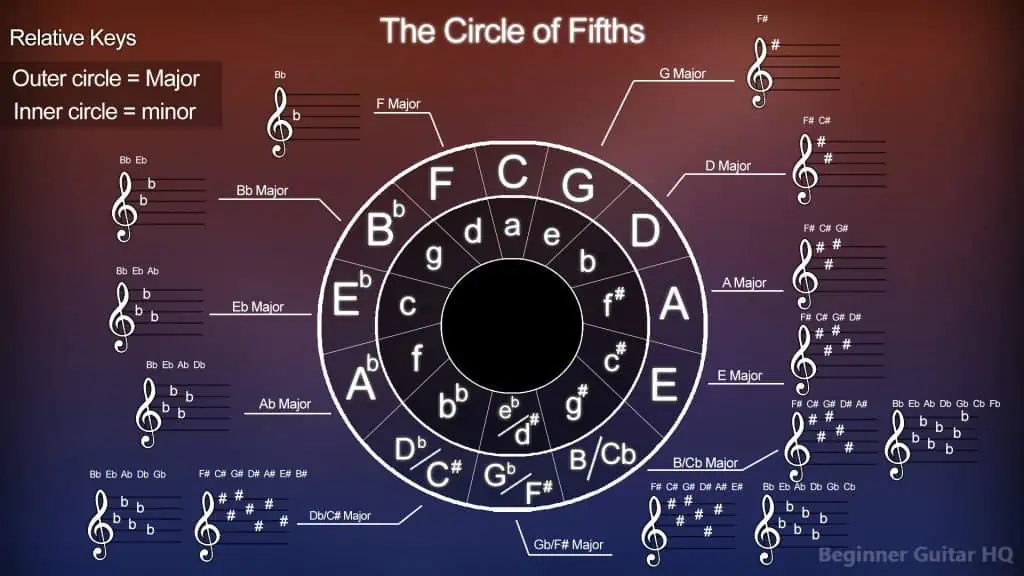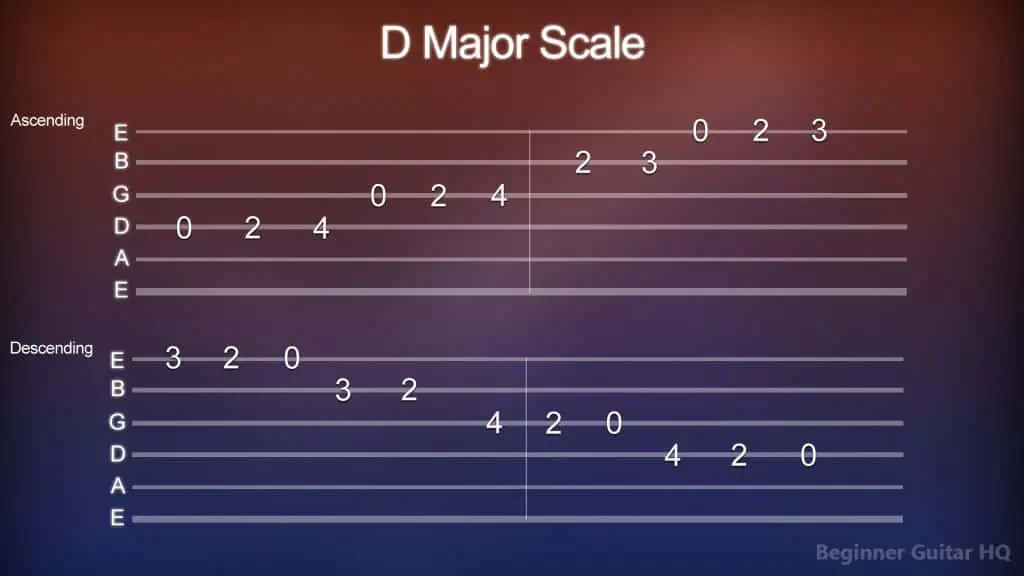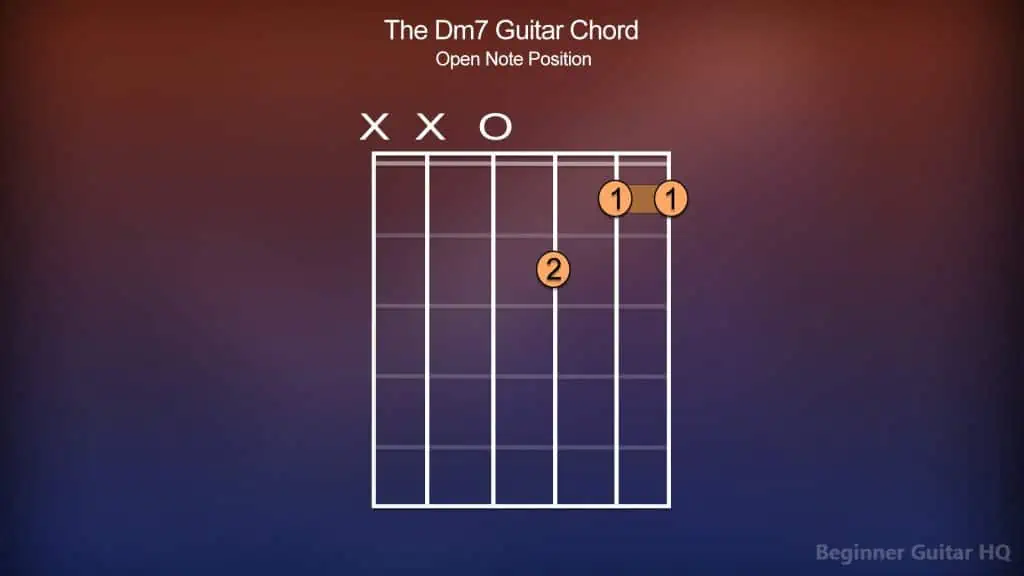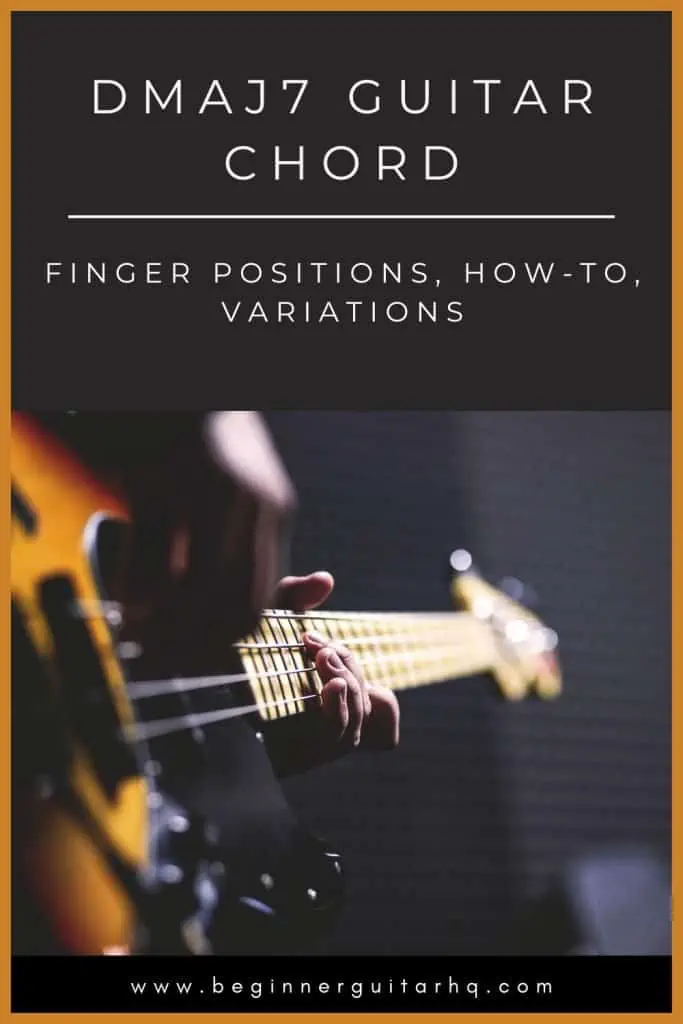Are you in search of some nice smooth and jazzy chords to add to your chord repertoire? Then you’ve come to the right place! The Dmaj7 chord is one of those particular chords that produce this type of sound. As you read onward, we’ll cover how to start playing this chord, as well as some of the music theory behind it, which may possibly extend to how you learn other chords! Let’s dive in!
Contents
How to Play the Dmaj7 Chord
The really neat thing about learning chords on the guitar is all of the unique ways we can play the same chord. We call these variations. Variations, not to be confused with inversions or inverted chords, don’t involve simply flipping chords on their head, but using the same core notes in different combinations, and sometimes more than once within the same chord!
Why use variations if they’re just the same chord? There are quite a few reasons why you might prefer to use one variation over another:
How the chord fits into the chord progression. You might prefer to choose a variation of a chord depending on how it helps your chord progression flow, for playability’s sake. For instance, if your chord progression is sitting around the 2nd fret, why play a chord on the 8th fret? It might not always make the most sense. However, the choice is up to the guitarist!
Your skill level as a guitarist. To go further on the playability of chords, you might prefer one over another based on your skill as a guitarist. You’ll likely want to play what will feel comfortable, and will keep your confidence high as a guitarist! It doesn’t hurt to challenge yourself as it can help you improve – however, don’t be too hard on yourself.
The tonal qualities. While, yes, they are technically the same chord, they also carry a slightly different sound from one another. This is due to the different combinations of notes within the same chord and where they fall. You may prefer a variation over another, based on this feature alone, and how it brings out different colors within the chord.
It’s a chord you may enjoy! Sometimes choosing one chord over another may come down to personal preference, which may involve any of the aforementioned points. The important thing is to choose a chord that you enjoy, and that fits with what you’re trying to play. There really are no wrong answers!
Without further ado, let’s cut right to the meat, and go over the Dmaj7 chord, as well as a few of its variations:
Chord chart of the Dmaj7 chord from the open note position.
Chord chart of the Dmaj7 chord from the fifth fret position.
Chord chart of the Dmaj7 chord from the tenth fret position.
Trouble With Chord Charts?
If this is your first time seeing a chord chart, you might feel somewhat overwhelmed. Don’t fret! Learning chord charts is a very simple process, and will serve you for years to come! Let’s begin by drawing our attention to the big rectangular square, housing a collection of vertical and horizontal lines; this represents our fretboard. Each vertical line represents a different string on the guitar. From the left to the right, we have our low E, A, D, G, B, and high E strings. Each horizontal line, however, separates one fret from the next!
On top of our strings, and within the frets, you’ll notice circles containing a number anywhere from 1 – 4. These numbers represent our different fingers, and where they’re to be placed on the fretboard to form our chord! The number 1 represents our index finger. The number 2 represents our middle finger. The number 3 represents our ring finger. Lastly, the number 4 represents our pinky finger. If, however, you notice a long dark bar stretching across a number of frets, this indicates that you’re to form a barre, used across various “barre chords”. To form a barre, you simply drape your index finger across a grouping of strings along an individual fret and apply pressure.
Next, bringing our attention to the top of the fretboard, you might notice an “O” or an “X” above a string. If there’s an “O” above the string, this indicates that you’re to play an open note (a string to be played, but not fretted). If, however, there’s an “X”, then that means you’re to not play the string to complete the chord. To the left of the fretboard, you might notice a number present. The number represents the starting fret in forming our chord. If there are no numbers present, however, then it’s generally implied that you’re starting from the open-note position.
That’s all there is to it!
Breakdown of the Dmaj7 Chord
The Dmaj7 chord, otherwise known as the D major seventh chord, carries a very smooth, sweet, and sophisticated sound. Chords like these are extensively used in the world of jazz music, adding a layer of tension with the 7th note being placed on top of a major triad. Generically, however, seventh chords like our friend, the Dmaj7 are not uncommon in the world of rock, blues, and country music. In fact, sometimes you’ll even find various types of seventh chords used in hip-hop, where a similar aesthetic is trying to be achieved.
So what is a major seventh chord?
In a nutshell, a major seventh chord contains a major triad, with an interval of a 7th stacked on top. When these four notes are played together, you get your major seventh chord! If this sounds confusing, don’t worry, we’ll cover it in further depth as you read on!
To better understand our Dmaj7 chord, in particular, we should cover three important factors that provide the makeup of our chord: the key, scale, and the triad.
Let’s begin with the key. Our key can be described as a grouping of musical pitches, no different than what you’d find within a scale. How are these pitches defined? This is where our key signature comes into play. Every key has its own key signature. The key signature is visually represented by a collection of sharps (#) and flats (b) following the clef on a piece of sheet music. When a note is marked as sharp, then it’s to be raised by a semitone. However, when a note is marked flat, then it’s to be lowered by a semitone.
So, how can we determine which notes will be sharp or flat within a given key? This is where it can help to consult the circle of fifths.
Diagram of the circle of fifths, displaying all of the most commonly used keys.
The circle of fifths is a wheel-shaped diagram displaying all of our most commonly used keys and their corresponding key signatures. Within the wheel, you’ll see two rings. The outer ring contains all of our major keys, while the inner ring houses all of our relative minor keys (keys that have a different root note but contain the same key signature).
Starting from C major, as you go clockwise around the wheel, you’ll notice that every key gains an additional sharp (#) to its key signature. On the other end of the spectrum, starting from C major and going counterclockwise, you’ll notice that every key gains an additional flat (b) to its key signature.
The key our chord Dmaj7 belongs to is D major, therefore, we’re on the right half of the wheel containing two sharps in the key signature. So, how do we determine which notes are to be sharp within our key signature? We use the simple acronym FCGDAEB. This stands for:
“Father, Charles, Goes, Down, And, Ends, Battle”
The idea is that the first letter of each word represents a different note that’s meant to be made sharp, following this sequence. Here’s how the sequence appears on the circle of fifths:
C = No sharps or flats.
G = F#
D = F#, C#
A = F#, C#, G#
E = F#, C#, G#, D#
B = F#, C#, G#, D#, A#
F# = F#, C#, G#, D#, A#, E#
C# = F#, C#, G#, D#, A#, E#, B#
For instance, if we were in the key of A major, knowing it has 3 sharps, using our fingers, we’d go “Father, Charles, Goes”. Therefore, the key signature of A major contains F#, C#, and G#. Let’s do one more. This time, we’ll use F# major, containing 6 sharps. Using our fingers once again, we’d go “Father, Charles, Goes, Down, And, Ends”. Therefore, the key signature of F# major contains F#, C#, G#, D#, A#, and E#.
Circling back, we know that D major contains 2 sharps within its key signature, so what notes are made sharp? That’s right, F# and C#! Now, let’s throw together our D major scale:
D > E > F# > G > A > B > C# > D
Major scales like our D major scale here have a strict pattern of tones (T) and semitones (S) that they always follow:
T > T > S > T > T > T > S
As you can see, our D major scale obeys this pattern to a tee! The first two intervals, D > E, and E > F# are tones apart. The third interval, F# > G, however, is a semitone! The fourth, fifth, and sixth intervals, G > A, A > B, and B > C# are all tones apart. Finally, the seventh interval C# > D is a semitone apart. It never fails!
Now, let’s give our D major scale a try:
Guitar tablature of the D major scale, ascending and descending.
Trouble With Tablature
Guitar tablature, otherwise known as “tab”, is an excellent means for guitarists to write, share, and play some of their favorite songs and exercises. In fact, you can consider guitar tablature a more simplistic alternative to sheet music/musical notation.
Let’s bring our attention to the six horizontal lines, as each of these is meant to represent a different string on the guitar. From the bottom to the top, we have our low E, A, D, G, B, and high E strings. On top of the lines, you’ll see numbers, indicating which fret you’re supposed to play on the corresponding string. For instance, if you see the number 3 on the A string, then you’re to play the 3rd fret of the A string. If you see the number 5 on the G string, then you’re to play the 5th fret of the G string. If, however, you see the number 0 on any string, then you’re to play an open note on that corresponding string (a string to be played but not fretted). That’s all there is to it!
Scale Degrees
Now that we’ve gone over a little about the D major scale, it’s important to know that every note with our scale plays an important role. We call these our different scale degrees. Each degree of our scale has its own unique name, to help musicians refer back to them with ease. Within the D major scale, here are our different degrees:
D = Tonic (1st Degree)
E = Supertonic (2nd Degree)
F# = Mediant (3rd Degree)
G = Subdominant (4th Degree)
A = Dominant (5th Degree)
B = Submediant (6th Degree)
C# = Leading Tone (7th Degree)
D = Tonic (1st Degree/Octave)
Now, let’s cover each degree in slightly more depth. Our first degree, the tonic, is our tonal center, the root note of whichever key we’re playing in. This degree provides a sense of calm, and resolve. The second degree, the supertonic, acts as a tension-building degree, sharing two notes with the subdominant triad. The third degree, the mediant, shares two notes with our tonic triad, thus making it an excellent degree for drawing our tonic out further. The fourth degree, the subdominant, is a tension-building degree, sharing but one note in its triad with the tonic, which happens to be our root note, D. Moving further away, the fifth degree, the dominant, is typically the peak of our tension, which wants to resolve back home to our tonic. It’s also important to note that the subdominant is the most important degree, second to our tonic. Next, our sixth degree, the submediant, acts as another predominant degree, sharing not only two notes with our tonic triad, but two notes with our subdominant triad. Next, we have our seventh degree, the leading tone, important in forming our seventh chords. This degree holds great tension, in fact, try playing the C major scale and ending on B; your ears will want to hear it resolve to C. Finally, we’re back on the tonic, just an octave higher from where we began.
Triads
A triad is a type of chord, containing three notes played in unison. To form a major triad, you need to take the tonic, mediant, and dominant degrees of the scale (1st, 3rd, and 5th degrees) and stack them on top of each other. To form a D major triad, you would need the notes: D, F#, and A.
Major triads contain specific intervals that give them their characteristically “happy sound”.
- Major 3rd – Between the 1st and 3rd degrees. D > F#.
- Minor 3rd – Between the 3rd and 5th degrees. F# > A.
- Perfect 5th – Between the 1st and 5th degrees. D > A.
However, if we want to convert our D major triad into a Dmaj7 chord, then we would need to stack the 7th degree of our D major scale on top. This would give us the notes: D, F#, A, and C#.
Finding Chords Compatible With D Major
It can be a challenge at times to create chord progressions, let alone ones that we like! Thankfully, however, there’s a method to make this task a little easier. Using what we now know about triads, we’ll begin stacking them on each degree of the D major scale:
D Major = D, F#, A (Tonic/1st Degree)
E Minor = E, G, B (Supertonic/2nd Degree)
F# Minor = F#, A, C# (Mediant/3rd Degree)
G Major = G, B, D (Subdominant/4th Degree)
A Major = A, C#, E (Dominant/5th Degree)
B Minor = B, D, F# (Submediant/6th Degree)
C# Diminished = C#, E, G (Leading Tone/7th Degree)
These are the chords that we can use in the key of D major.
Dmaj7 to Dm7
We’ve covered quite a bit about the Dmaj7 chord, but what about its minor counterpart, Dm7? Well, it’s first important to note that the relationship between D major to D minor is that of a parallel key relationship. This is where they share the same tonic, but contain different key signatures. Unlike, D major to B minor, containing a relative key relationship, where instead they have different tonics, but share the same key signature.
So, what’s the key of D minor?
If we look at the circle of fifths, we’ll see that D minor falls on the left half of the wheel containing keys with flats in their key signature. So, how do we find out the flats within each key? We simply take our acronym from earlier FCGDAEB and reverse it to BEADGCF. This stands for:
“Battle, Ends, And, Down, Goes, Charles’, Father”
Knowing that the key of D minor contains 1 flat within its key signature, we can determine that the key signature of D minor is Bb. Now, let’s lay out our D minor scale:
D > E > F > G > A > Bb > C > D
Minor scales, much in the way major scales do, contain their own set pattern of tones (T) and semitones (S):
T > S > T > T > S > T > T
As you can see, the first interval, D > E is a tone apart. Following that, the second interval, E > F is a semitone apart. The third and fourth intervals, F > G, and G > A are both tones apart. The fifth interval becomes Bb > C, due to the key signature, making it a semitone apart. Finally, the sixth and seventh intervals, Bb > C, and C > D are a tone apart. It always checks out!
Moving on, when we are building a minor triad, the same rules apply as they did when we built our major triad. We simply take the tonic, mediant, and dominant degrees of our scale (1st, 3rd, and 5th degrees) and stack them on top of each other. When building a D minor triad, this gives us the notes: D, F, and A.
However, minor triads, contain their own specific set of intervals that give them their characteristically “sad” and “melancholy” sound:
- Minor 3rd – Between the 1st and 3rd degrees. D > F.
- Major 3rd – Between the 3rd and 5th degrees. F > A.
- Perfect 5th – Between the 1st and 5th degrees. D > A.
Do you see the difference? It’s reversed! The first interval in a minor triad is a minor 3rd, while in a major triad, it’s a major 3rd. The second interval within a minor triad is a major third, while in a major triad, it’s a minor 3rd. The perfect 5th remains the same in both!
If we want to convert our D minor triad to a Dm7 chord, then as before, we take the 7th degree of our D minor scale and stack it on top. This gives us the notes: D, F, A, and C.
Now, let’s try playing our Dm7 chord:
Chord chart of the Dm7 chord played from the open note position.
Conclusion
Now you have all of the tools to get started with your Dmaj7 chord, and then some! These chords can be an excellent way of spicing up chord progressions you’re already familiar with, and an excellent way of adding more color and variation. What will you do with seventh chords? Will you learn other kinds of seventh chords, or perhaps, 9th, 11th, or even 13th chords? There are so many options. The important thing is to have fun and keep things exciting. Wherever your endeavors take you, remember to keep on rockin’.

